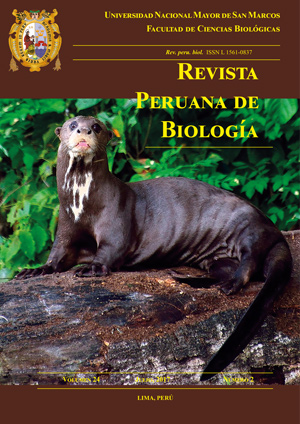Habitat use and conservation status of birds from El Paraíso wetland, Lima, Peru
DOI:
https://doi.org/10.15381/rpb.v24i2.13494Keywords:
El Paraíso, wetland, birds, habitat use, conservation.Abstract
Birds are the most representative group of wetlands. In the Central Peruvian coast many of these ecosystems are severely affected by anthropogenic activities, for instance, El Paraíso wetland. The aim of this study is to evaluate the preferences and habitat uses of two aquatic bodies: brackish lagoon and marshy area at El Paraíso Wetland, in order to gather information for the implementation of management plans and conservation of this wetland. From May 2009 to March 2010, we carried out monthly assessment by point counts technique. We identified 68 species that made direct use of the studied habitats. The most abundant families were Anatidae (19.2%), Laridae (18.0%), Phalacrocoracidae (16.8%) and Rallidae (16.1%). The most abundant species was Phalacrocorax brasilianus (16.7%), followed by the Fulica ardesiaca (13.0%). We found marked differences in the composition of birds’ communities between the two evaluated habitats, which mainly occurred due to the presence of boreal migratory species that prefer swampy habitat. Nesting sites of representative species of wetland such as, Phalacrocorax brasilianus, Tachuris rubrigastra, Phleocryptes melanops and Charadrius nivosus were recorded. The most common bird activity recorded was resting (73.9%), followed by feeding (23.4%) and breeding (2.73%). The main threats to the wetland are, hunting, burning (cattails and rushes), vehicular traffic by seashore, solid waste and debris left by the swimmers.Downloads
Downloads
Published
Issue
Section
License
Copyright (c) 2017 Alessandra S. Quiñonez, Flor Hernandez

This work is licensed under a Creative Commons Attribution-NonCommercial-ShareAlike 4.0 International License.
AUTHORS RETAIN THEIR RIGHTS:
a. Authors retain their trade mark rights and patent, and also on any process or procedure described in the article.
b. Authors retain their right to share, copy, distribute, perform and publicly communicate their article (eg, to place their article in an institutional repository or publish it in a book), with an acknowledgment of its initial publication in the Revista Peruana de Biologia.
c. Authors retain theirs right to make a subsequent publication of their work, to use the article or any part thereof (eg a compilation of his papers, lecture notes, thesis, or a book), always indicating its initial publication in the Revista Peruana de Biologia (the originator of the work, journal, volume, number and date).


















